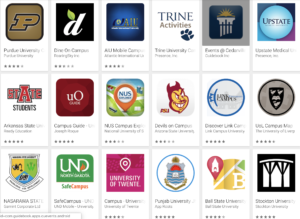By now it’s no secret that apps and mobile devices are the perfect tools for communication. Institutions in nearly every industry have jumped in head first to the mobile app craze. From grocery stores and boutiques to your local dentist, native apps are everywhere and now they’ve taken over higher education.
In fact, when you search for a university in the app store, there are seemingly hundreds of apps for every organization on different campuses worldwide. Despite the numerous apps available at universities, faculty often feel that apps and mobile devices cause students to be distracted in class and are more of a nuisance than an educational aide. According to the “2018 Global Mobile Consumer Survey,” the average American checks their phone more than 52 times per day.

What many don’t consider is how these apps and mobile devices can keep students engaged and actually help them learn. Eighty-seven percent of university students use apps to help them study and another 75 percent of students feel that the use of personal devices in the classroom actually improved their ability to learn and retain information.
To better understand how students use mobile apps, let’s take a look at some of the ways mobile devices and campus apps can impact student success.
Tearing down the barrier to information
Universities are often a melting pot for students from all different backgrounds, including many from a low-income background. While many institutions offer computers within academic buildings, students still need a way to have access to information at all times.
While laptops have become more affordable in the past 5-10 years, laptops can still cost between $300-500, which is an unaffordable price for many students and their families. Without a portable computer like a laptop, the only way students can have access to important information 24-hours a day is through the use of apps on mobile devices. Tearing down the barrier to information is vitally important for students to access class information, grades or even assignments. If a student has to take extreme measures to access academic information, they will likely fail.
Increased student retention
Students often transfer or drop out because they cannot find their place and are uninvolved in campus activities or organizations. Universities can utilize machine learning within apps to notice these trends and send notifications to help entice a student to get involved.
A recent report from Campus Technology found that personalized messages within campus apps which “nudged” students to stay on track and get involved improved retention rates by 10 percent compared to those who did not receive these messages. Devices should be central to student success strategies and these personalized messages will not only help the university maintain a low turnover rate but also help to produce more prepared and successful graduates. When you consider that the same study found that the personal messages helped students improve time management skills, keep up with financial aid renewal as well as feel more connected to their university in general.
Improved learning environment
Motivation should be one of the most important factors that should be considered when looking at helping students focus on their studies and be successful academically. Everyone has a preferred method or platform from where they prefer to consume information. For students, that platform is mobile apps and devices. As stated above, 75 percent of students feel that using their devices in the classroom helps them retain information and another 94 percent want to use their phone for their studies. With such a high demand from students, the smart use of mobile apps within the classroom is crucial for any university concerned with student satisfaction and academic success.
Increased retention rates, easily accessible information and improved student satisfaction and success, sounds pretty great right? This is all achievable for higher education institutions through the strategic use of mobile apps for learning, engagement and long-term student success. While many feel that mobile devices are too distracting to have in the classroom, it’s time to see the benefits and accept the fact that they far outweigh the negatives.